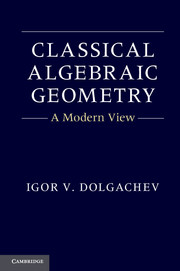7 - Cremona transformations
Published online by Cambridge University Press: 05 September 2012
Summary
Homaloidal linear systems
Linear systems and their base schemes
Recall that a rational map f: X ⇢ Y of algebraic varieties over a field K is a regular map defined on a dense open Zariski subset U ⊂ X. The largest such set to which f can be extended as a regular map is denoted by dom(f). A point x ∉ dom(f) is called an indeterminacy point. Two rational maps are considered to be equivalent if their restrictions to an open dense subset coincide. A rational map is called dominant if f: dom(f) → Y is a dominant regular map, i.e. the image is dense in Y. Algebraic varieties form a category with morphisms taken to be equivalence classes of dominant rational maps.
From now on we restrict ourselves to rational maps of irreducible varieties over ℂ. We use fd to denote the restriction of f to dom(f), or to any open subset of dom(f). A dominant map fd: dom(f) → Y defines a homomorphism of the fields of rational functions f*: R(Y) → R(X). Conversely, any homomorphism R(Y) → R(X) arises from a unique equivalence class of dominant rational maps X ⇢ Y. If f* makes R(X) a finite extension of R(Y), then the degree of the extension is the degree of f. A rational map of degree 1 is called a birational map. It can also be defined as an invertible rational map.
- Type
- Chapter
- Information
- Classical Algebraic GeometryA Modern View, pp. 280 - 346Publisher: Cambridge University PressPrint publication year: 2012

